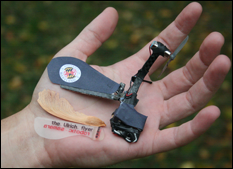I love Body-Boards.
They are poor man´s surfboards for for non-hawaiian non-californian or non-seaside residents like me.
A Body-board should be the ideal platform for carrying all that electronics.
How was i wrong!
The only thing which was missing is an adequate propulsion system.
The first try was an electric bilge pump. As already mentioned above, i don´t like propellers in the water, because they will easily fall in love with water-plants.
A bilge-pump seemed the ideal solution, because it has a shielded propeller, which is well adapted to the motor by a gear.
The outlet of the pump was connected to a silicon tube, the steering was done by a servo that bent the tube to the right and the left.
Yes it worked - in principle -
But the thrust of the pump was not high enough to get an adequate speed and the tube-bending assembly had not enough "angle" to make good turnrates.
Sorry, no pictures are left from that assembly.
Still the idea with the body-board.
I skipped the idea with the bilge pump, anyway a model with a better throughput may have done the job....
Till this point all assemblies have been very very crude ones, stucked together with gaffer-tape and hot glue. The only purpose of this assembles was to prove, if the concept is OK.
Till then it obviously was not.
Then i went in a more serious phase, when i entered again the local RC retailer shop and left it with a BLDC Motor-propeller assembly from Multiplex.
It was a kit for pimping the Park Master from Multiplex, the "Power drive "ParkMaster 3D" #332638". See /http://www.multiplex-rc.de/ for details.
The Parkmaster pimping kit.
This kit was mounted on an alumnium plate, which was recycled from an old 19" rack. The steering was done by an air-rudder, which was made from a PVC foam board. It looked a little bit like an oversized side-ruder of a model plane. Thrust was OK now, but the steering was not. In principle it worked, but the air-rudder had not enough "power" to give a good steering quality. Additionally, the left and right curve radiuses (or is it radii ?) were different, because the simple "steel-wire-rudderhorn-servo-coupling" was not symmetric.
And, most of all, the body board had no keel, which makes it very instable. Holding a straight-line course is like juggling with three balls (and i hardly can do that with one). Adding a few stripes of PVC-foam-boards on the bottom of the board made it better but not good enough.
This is the Body-Board with the air-rudder. Still with telemetry, still RC controlled.
Next Try: I mounted the BLDC Motor with the propeller on a PVC Tube and put it on a PVC pivot so that the whole assembly can be turned by a servo. Looks a little bit like a windmill. This led to better results for the control of the Body-Board, but the stability for driving a straight line was still not satisfying.
The first approach was to connect the PVC tube to the servo by an an O-Ring. Worked, but was a little bit sloppy when the tension on the O-Ring is too low and gave to much force on the shaft of the servo, when the tension was OK. So i decided to connect it "classically" with steel-wire and rudder-horns.
I kept this propulsion-approach for all further platforms, because it proved to be very robust.
The Windmill assy with O-Ring connection. Sloppy...
The Windmill assy with steel-wire and horns. much better..
Thats all for today, next episode will focus on a more serious hull, the introduction of ArduPilot and the black day.
